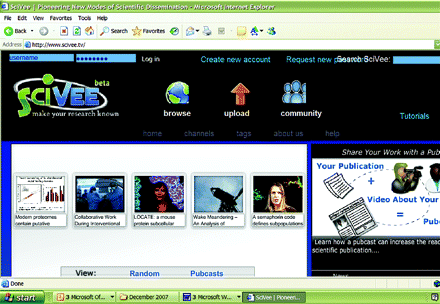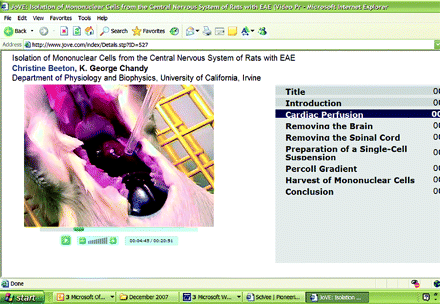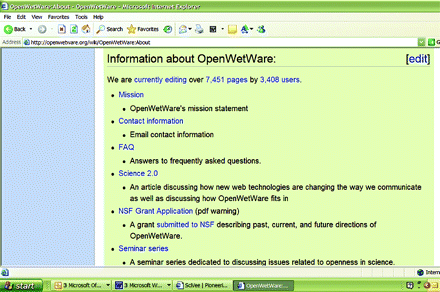Sites of interest on the World Wide Web—edited by David L. Roman
Popular, non-science Web sites are developing almost cult-like followings, and names like MySpace, FaceBook, and YouTube are the beginnings of many news stories in the mass media. As it turns out, there are some scientific equivalents of these popular sites. Some of these are in their nascent stages, whereas others are very well developed. This month, we’ve taken a look at a few sites that are an awful lot of fun to browse around, embracing the trend toward community building and sharing. (And yes, they really are educational and full of useful tools.)
SCIVEE – Make Your Research Known

A very interesting experience is offered at www.scivee.tv. This Web site is dedicated as a public portal for the dissemination of scientific information in a predominantly video-based form. The development of this site, supported by a partnership with the Public Library of Science, the National Science Foundation, and the San Diego Supercomputer Center, serves as a depository for scientists to communicate their work in a format somewhat new to the scientific community. Through video-casts and even more basic PowerPoint-style presentations, people from around the world can not only learn about your research, but can also see you talk about and explain the concepts fundamental to your work. This Web site presents science at the research level, with presentations ranging from a slide show on the BRCA1/2 Pathway to a video promising to explain, “A semaphorin code defines subpopulations of spinal motor neurons during mouse development.” The site is not limited to biological sciences, as it also includes video explanations of research in other fields, such as how to accomplish laser alignments or create subtitles in the Quicktime video encoder. These types of visual explanations of complex concepts offer a much richer and understandable experience than simple printed instructional matter. Scivee is a great place to learn, but also serves as a place for us as scientists to place information about our research so that colleagues and others can keep up with the work we do.
JOVE – Journal of Visualized Experiments

JOVE (www.jove.com) relates broadly to the biological sciences community, with concentration on basic research in neuroscience, immunology, cellular biology, plant biology, microbiology, and more. You’ll find a plethora of video-based tutorials and protocols useful to the biological sciences researcher. The high-quality videos include methods for recombinant protein expression, isolation of mononuclear cells from rat central nervous system, and microinjection techniques, just to name a very few. JOVE is also a user-supported community, inviting researchers to upload video protocols and methods for the benefit of other investigators. As JOVE is modeled as a video-based journal, an impressive editorial board of respected scientists is in place to ensure the quality of content. The medium of expressing scientific ideas and research discoveries includes more than just the printed page, and Web sites such as JOVE are filling a new niche in acting as a depository for video-based research publication and presentation.
OpenWetware


OpenWetware (www.openwetware.org) is a unique Web site that blends the concepts of a “Wiki” with additional functionalities that are focused on lab management and organization. The site’s usefulness is accessible in a straight-forward approach: your lab sets up an account, and OpenWetware provides space for storing protocols, inventory lists, personal Web pages, links, and—perhaps most useful of all—a calendaring system. In many labs, managing instrument time, lab meetings, journal clubs, and seminars requires the use of disjointed Web sites, calendar servers, or paper postings. On OpenWetware, all of these tasks can be accomplished through a simple lab Web site. The additional advantage is that it requires no HTML, XML, CSS, or any other programming knowledge. Access to the Web is the only prerequisite, and authorized users can make changes and update the site through any Web browser. OpenWetware is also unique in its “open concept,” whereby you can view other labs’ Web pages, share protocols and even data with colleagues. The Web sites are organized by area and by institution, making it easy to find the content provided by your colleagues. Furthermore, the site has a wide array of free software downloads and links to pages with tools that would be useful to researchers, including a dedicated section of free software tools for crystallographers. While OpenWetware may not enjoy the widespread fame of other social-networking sites such as MySpace, it provides a wide array of tools and reasonably promises to make lab organization much easier and efficient.
- © American Society for Pharmacology and Experimental Theraputics 2007



